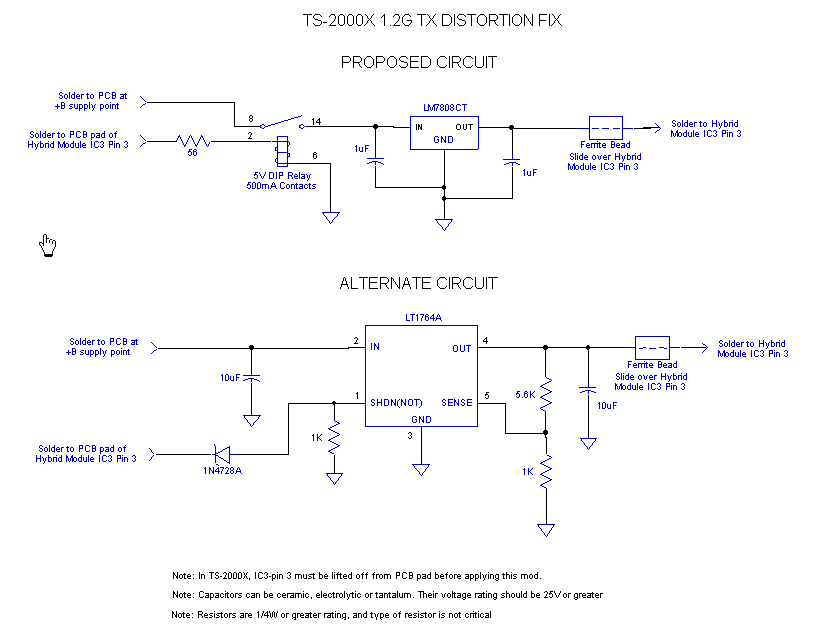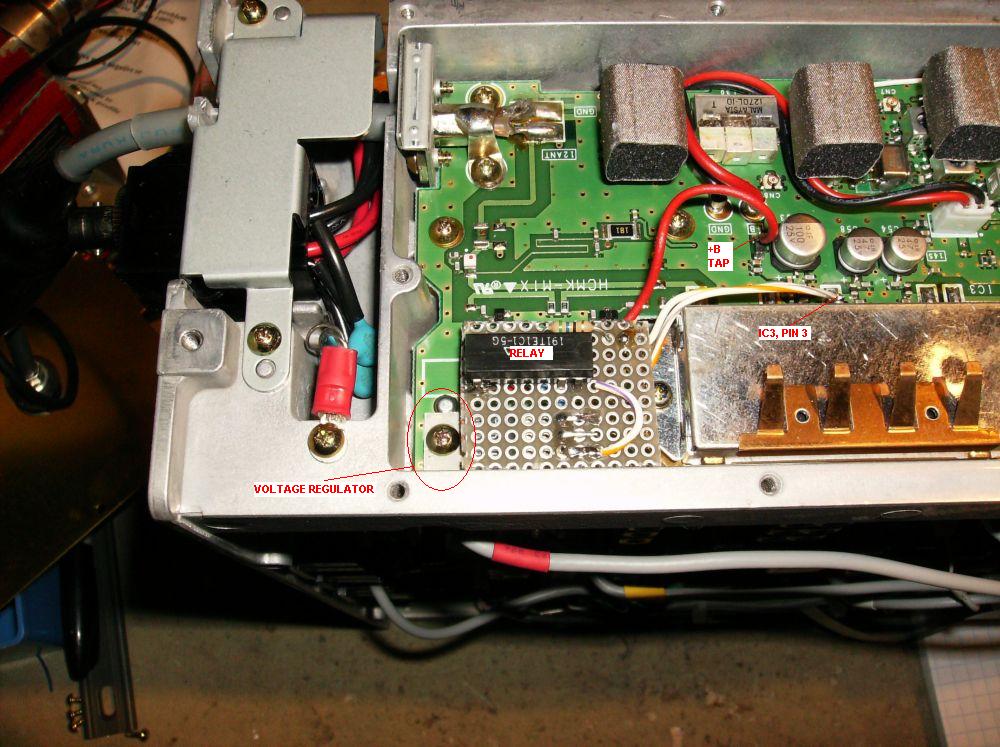|

|
|
Kenwood TS-2000X 1.2GHz
Tx Distortion problem and fix
By: Bertrand
Zauhar, VE2ZAZ
The
Kenwood TS-2000X amateur radio transceiver is a great radio because it
covers HF, VHF, UHF and L-band all in one box. It is not perfect on all
fronts but it does everything well, much like a swiss pocket knife.
Like most radios, it has some flaws though. One bug I discovered is a
severely distorted SSB transmission on models built prior to year 2006.
I happen to own one of these. Here is a detailed description of what
I found and what I did to cure it.
One
day, I decided to try the L-Band function on my TS-2000X in preparation
for the ARRL June VHF contest. To my surprise, the other party reported
that I had a very distorted audio in SSB and that he could barely
understand what I was saying. Everything was fine in Rx. This sounded
like a major case of non-linearity to me.
Following
that evening, I did some research on the internet and found hints of
what might have been happening. Others reported a design flaw kept
quiet by Kenwood. The flaw is that the two hybrid power modules used as
Tx driver and Tx power amplifier were under-biased on the Vbb pin for
rigs dating earlier than 2006. Since my TS-2K's serial number starts
with a 6 (which means 2004), I knew that my unit might be
part of the defective batch.
So I
called up Kenwood USA. A service person (nice,
I must say) answered but provided little detail on
the actual problem, other than confirming that there was a fix
available and that Kenwood would have to do it for me since it involved
a re-calibration via software of some of the internal parameters. He
provided no detail of the fix. The bad news was that I would have to
pay for THEIR design flaw... The reasons were that they gave only a one
year warranty extension to the original warranty for this fix; my rig
is older than that. The other problem is that I was not the original
owner of the rig. Who cares!
I
decided that I would not miss the VHF contest a couple of weeks later,
so I went ahead and opened up the hood on the TS-2KX to try to better
assess the problem. I probed the Vbb DC biases on pin 3 of the two
modules when in Transmit and saw
what follows:
| Hybrid Module |
Measured |
Specified |
Absolute Maximum
|
| Driver IC2 |
6.2V |
8V |
9V |
| P.A. IC3 |
6.8V |
9V |
10V |
The
Mitsubishi specsheets specify a bias of +8Vdc and +9Vdc, with an
absolute maximum value of +9Vdc and +10Vdc respectively. So the
modules were clearly under-biased and the values
corresponded to the problem description I had read on the internet, but
was it really the source of problem?
Next,
I decided to probe the RF signal to hear from where the distortion
originated. I used a 20:1 resistive RF probe, fed its signal into a
60dB power attenuator and
on to a receiver capable of tuning to 1296MHz. I
terminated the antenna
connection into a dummy load. I then keyed up the
1296 transmitter and probed the RF lines at the
input of IC2, between IC2 and IC3 and at the output of IC3. I quickly
determined that IC3, the P.A. hybrid, was the source of severe
distortion.
Disconnecting
IC3, pin 3 from its PCB connection is
a rather simple thing to perform; it is just a matter of carefully
lifting off the pin while heating up with a soldering iron. So I just
did that. I then set the voltage on an
external power supply to
+8Vdc and connected it up to pin 3. I saw a constant 300mA of
current flowing. The absolute maximum current specified is 500mA so
everything looked nominal. I then transmitted again and YES!!! Clean SSB signal. I then knew
how to fix it.
The following were the facts
that I had to deal with in my implementation of a fix:
- When the Vbb is applied, the IC3
module
draws a constant 300mA. So the Vbb bias is switched on only when the
radio is transmitting on the 1.2GHz band
- There is no +8Vdc available in the
vicinity of the 1.2GHz board
- IC2, the driver hybrid module worked
well as is.
I basically had two
approaches I could implement. One involved a relay and a LM7808 voltage
regulator, the other involved a fancier adjustable voltage
regulator equipped with a shutoff pin, such as the Linear Technology
LT1764A. Since the latter cost around 10$ and would have required a
mail-in order with shipping fees, I decided to implement the first
solution. The next time I order from Digikey, I will probably add the
LT1764A regulator to my order anyway, just in case.
The
two proposed solutions are shown on the schematic on the right hand
side. Both will produce a solid +8Vdc when in transmit mode. In both
solutions, the old Vbb signal is used to switch the new bias. Simple
and effective. Now
remember that you have to first lift up pin 3 of IC3 from its PCB pad.
If you do not like the DIP relay solution, just implement the LT1764A
solution shown at the bottom of the schematic page. Note that I have
not tested it, but I have simulated it in PSpice and I have every
reason to believe that it will work. The Zener diode and the neighbor
1K resistor are probably optional, but they guarantee a complete
shutoff in case the Vbb bias is not quite 0V in Rx mode.
The picture to the right shows how I physically implemented the new
bias circuit. I used a piece of plated-through-hole prototype PCB. The
lower-left corner of
the 1.2GHz board is pretty much empty, with only the ground plane
covering the surface. The 7808 voltage regulator is mounted underneath
the PCB, so that its tab can be screwed against the PCB ground plane
using the PCB corner screw. The voltage regulator tab can be seen to
the left of the proto PCB. I used thermal compound to better transfer
the heat to the PCB and chassis. The voltage regulator pins support the
PCB. Care has to be taken so that the
overall assembly profile fits under the 1.2GHz compartment cover.
|

Click
on the figure to
enlarge it.

Click
on the figure to
enlarge it.
|
That is all there is to it. No calibration
parameter to tweak. In fact, I don't know what Kenwood were referring
to when they said that their fix would require a re-calibration of the
radio.
Since IC2, the driver module, did not manifest the same problem, I
decided not to touch it. When ain't broken, don't fix it...
Enjoy!
|
